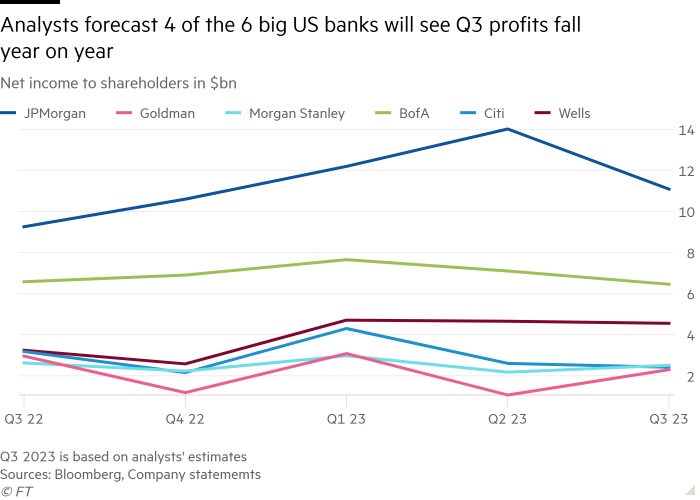Rising interest rates curb lending growth for big US banks

Simply sign up to the US banks myFT Digest -- delivered directly to your inbox.
Slowing growth in lending risks curbing a key driver of profits for the big US banks when they begin reporting third-quarter earnings this week.
Net interest income — the difference between what banks pay on deposits and what they earn from loans and other assets — has in the past 18 months lifted earnings for the likes of JPMorgan Chase, Bank of America and Citigroup.
The biggest US banks have benefited from charging more for loans in lockstep with the Federal Reserve lifting benchmark rates without significantly raising interest rates for savers.
And while weekly data from the Fed has shown credit card borrowing by consumers is still growing, albeit at a slower pace, corporate borrowing has fallen in the past six months. Analysts blame rising rates.
“Loan growth has slowed dramatically,” Morgan Stanley banking analyst Betsy Graseck wrote in a note to clients last week. “Our view is weak loan growth reduces NII growth into 2024.”
According to Morgan Stanley analysts, the 25 largest US banks by assets had loan growth slow considerably since the start of the year to about 1.5 per cent from a year earlier, when it had been tracking at 8 per cent.

Banks have also become more selective about the loans they make in anticipation of proposed new US requirements for large banks — the so-called Basel III Endgame — which would increase the amount of loss-absorbing capital they would have to hold against their assets.
The Financial Times reported last week that JPMorgan has stepped up the pace at which it is securitising billions of dollars of its loan portfolio in anticipation of the new rules.
“Expect a lot of discussion on the earnings calls around the Basel III Endgame in terms of what the expected impact is with the current proposal, and then what actions banks plan to undertake to mitigate the likely increase in risk-weighted assets,” said Jason Goldberg, banking analyst at Barclays.
JPMorgan, Citi and Wells are the first of the four largest US banks by assets to report results for the three months until the end of September, disclosing earnings on October 13. BofA report results on October 17.
Goldman Sachs and Morgan Stanley, whose businesses skew more towards investment banking, trading and asset management, report results on October 17 and 18, respectively.
Analysts are forecasting that JPMorgan and Wells Fargo will be the only banks whose profits rose in the third quarter compared to a year earlier, according to consensus data compiled by Bloomberg.
Adding to a squeeze on bank profits is pressure to offer customers higher savings rates to keep their deposits, which are banks’ primary source of funding.
Big banks such as JPMorgan and BofA amassed record levels of deposits during the pandemic but these amounts have been coming down over the past 18 months as the Fed lifted interest rates. The big banks increased rates for loans but did not pass on higher rates for savers, resulting in low so-called deposit betas.
Data on Thursday from the Investment Company Institute showed money market funds, which can now yield upwards of 5 per cent for investors, took in $64.1bn for the week ending October 4, bringing the industry total to $5.7tn.
With the consensus now hardening that the Fed will keep interest rates higher for longer, analysts anticipate banks will be lifting rates for savers to hold on to deposits.
The concerns have hit bank stocks last week which have lagged behind the broader market.

“The performance of the bank stocks right now is reflecting concerns that are a little bit more about the next couple of quarters,” said John McDonald, senior analyst for large-cap banks at Autonomous Research.
“What will the path on capital look like if rates stay high? What will the deposit beta behaviour be? What will the pressure be on funding costs? And what will the pressure be on capital?”
The banks will face questions around how rising interest rates are affecting consumers, who have been steadily spending down savings they accumulated during the pandemic. This has meant loan losses have been at historically low levels but banks have warned for months that losses would tick up.
Analysts forecast that the net charge-offs — the portion of loans with losses that are marked as unrecoverable — will rise for JPMorgan, BofA, Citi and Wells to pre-pandemic levels.
“At some point, presumably, even the strongest consumers will begin to fold under the pressure of higher rates,” said Scott Siefers, a bank analyst at Piper Sandler.

In investment banking, analysts are forecasting revenues at JPMorgan, Goldman, BofA, Morgan Stanley and Citi were on average down about 4 per cent for the third quarter. But there is optimism that activity is picking back up after a prolonged slowdown — analysts predict Goldman will eke out a year-on-year rise in investment banking fees for the first time since the end of 2021.
Fixed income and equity trading revenues are predicted to have fallen an average of 5 per cent at the five banks in the quarter. Goldman is expected to have suffered the steepest drop, with analysts forecasting trading revenue fell 15 per cent from a year earlier when it benefited from volatile markets around central banks lifting interest rates.
Comments